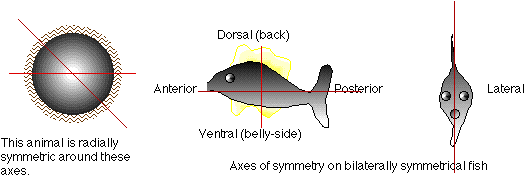
Biology
Chapter 18: 1-10 Simple Invertebrates

Lecture
Animals: Classification by Body Plan
WebLecture Topics
The Classification of Animals
We identify animals as multi-cellular organisms which draw their carbon from organic sources (not from the air, as plants do), and their energy from organic sources as well. As in all other areas of biology, classification of animals is undergoing a revision as we identify similarities in DNA, RNA, and proteins used in similar ways. However, the starting point for classification is still the form and structure of the animal.
General Characteristics and Body Structure
Animals differ from other organisms in several important ways.
- They are all multicellular eukaryotes, which means their individual cells have a certain kind of membrane, include nuclei and other organelles like Golgi bodies and mitochondria.
- The individual cells perform specialized functions in all but the simplest animals.
- They are heterotrophs, consumers which ingest their food and then digest it inside the body.
- Most have well-developed sense organs and nervous systems which allow them to respond to their environment.
- While some simple animals can reproduce asexually as well, all reproduce sexually, with non-motile eggs and motile sperm that unite to form a fertilized egg or zygote.
Biologists depend heavily on body shape and structure in order to classify animals. We have special terms which we use to refer to the symmetry, or ability to produce a mirror image along some axis or line draw through the body. Radially symmetric animals have a body plan which produces a mirror image when any of several lines are drawn through the center of the body. A body which is symmetrical around only one axis through the middle of the body is bilaterally symmetrical. We can still divide the body into several regions for identification purposes. The dorsal region refers to the backside of the animal, the ventral region to its belly-side. The anterior region is the "front", which may also include the cephalic or head region. The posterior is opposite the anterior region and often includes the tail or caudal section of the animal. The sides are the lateral regions.

Early development
All animals begin as single-celled zygotes. The zygotes divide into more and more cells, which form a hollow sphere or blastula. The cells of the blastula can remain neatly aligned, or they can shift to form a spiral pattern. Animals with aligned blastula usually become deuterstomes; animals with spiral cleavage patterns become protostomes. The blastula eventual forms a pocket (gastrula phase) and in deuterstomes, forms additional pockets that usually lead to animals with coelom. In protostomes, the coelom cavity may or may not form. Most animals with a simple body plan are protostomes, formed from the spiral cleavage of the blastula.
The following animal classification system is based on dividing animals into groups by their body structure—whether or not they possess a coelom, and then by other structural or functional characteristics. Biologists tend to do comparisons that focus on the complexity of particular systems, so it is interesting in the groups below to note the components and organization of the digestive, reproductive, nervous, respiratory, and circulatory systems.
Invertebrates
| Animals without a coelom
or with a pseudocoelom |
Simple body plans; Porifera and Cnidarians are radially symmetric. Primitive nervous systems and sensory organs, simple to complex digestive and reproductive systems. No skeletal structure.
|
|---|
At this point, differences become very difficult to track, so the following summeries are more general. See Web Lecture Invertebrates with Coelom.
© 2005 - 2024 This course is offered through Scholars Online, a non-profit organization supporting classical Christian education through online courses. Permission to copy course content (lessons and labs) for personal study is granted to students currently or formerly enrolled in the course through Scholars Online. Reproduction for any other purpose, without the express written consent of the author, is prohibited.

